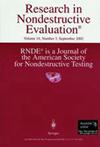The Effect of Motion-Induced Eddy Current on High-Speed Magnetic Flux Leakage (MFL) Inspection for Thick-Wall Steel Pipe
IF 1.6
4区 材料科学
Q3 MATERIALS SCIENCE, CHARACTERIZATION & TESTING
引用次数: 20
Abstract
ABSTRACT The magnetic flux leakage (MFL) inspection technology is widely used in pipeline industry to detect defects to ensure pipeline safety. During the high-speed inspection, a relative motion occurred between the pipeline inspection gauge (PIG) and the steel pipe wall will generate motion-induced eddy current (MIEC). There is a lack of research on analyzing the effect of MIEC on high-speed MFL inspection for thick-wall steel pipe. In this article, a three-dimensional (3D) finite-element method (FEM) simulations are conducted with an inspection speed range of 0 m/s to 8 m/s and a wall thickness range of 8 mm to 15 mm. Simulation results show that both high-speed inspection and thick-wall thickness will decrease the magnetization of steel pipe. It is observed that, at the speed of 8 m/s and the thickness of 15 mm, the magnetic field strength is lower than 2 kA/m and the steel pipe exits from the magnetic saturation zone, which causes the severe distortion of three-axis MFL signals, and the signal-to-noise ratio (SNR) is lower than 6 dB. A high-speed PIG is developed here for experiments to measure the three-axis MFL signals. The characteristics of simulated and measured MFL signals are found to be quite consistent.运动感应涡流对厚壁钢管高速漏磁检测的影响
漏磁检测技术广泛应用于管道工业,用于检测管道缺陷,保证管道安全。在高速检测过程中,管道检测仪表(PIG)与钢管管壁之间发生相对运动,产生运动感应涡流(MIEC)。关于MIEC在厚壁钢管高速漏磁检测中的效果分析研究较少。本文在检测速度为0 ~ 8 m/s,壁厚为8 ~ 15 mm的条件下进行了三维有限元模拟。仿真结果表明,高速检测和厚壁厚度都会降低钢管的磁化强度。观察到,在速度为8 m/s、厚度为15 mm时,磁场强度小于2 kA/m,钢管退出磁饱和区,导致三轴磁流变信号失真严重,信噪比小于6 dB。本文研制了一种高速PIG,用于实验测量三轴MFL信号。模拟和实测的磁振子信号的特性是相当一致的。
本文章由计算机程序翻译,如有差异,请以英文原文为准。
求助全文
约1分钟内获得全文
求助全文
来源期刊

Research in Nondestructive Evaluation
工程技术-材料科学:表征与测试
CiteScore
2.30
自引率
0.00%
发文量
14
审稿时长
>12 weeks
期刊介绍:
Research in Nondestructive Evaluation® is the archival research journal of the American Society for Nondestructive Testing, Inc. RNDE® contains the results of original research in all areas of nondestructive evaluation (NDE). The journal covers experimental and theoretical investigations dealing with the scientific and engineering bases of NDE, its measurement and methodology, and a wide range of applications to materials and structures that relate to the entire life cycle, from manufacture to use and retirement.
Illustrative topics include advances in the underlying science of acoustic, thermal, electrical, magnetic, optical and ionizing radiation techniques and their applications to NDE problems. These problems include the nondestructive characterization of a wide variety of material properties and their degradation in service, nonintrusive sensors for monitoring manufacturing and materials processes, new techniques and combinations of techniques for detecting and characterizing hidden discontinuities and distributed damage in materials, standardization concepts and quantitative approaches for advanced NDE techniques, and long-term continuous monitoring of structures and assemblies. Of particular interest is research which elucidates how to evaluate the effects of imperfect material condition, as quantified by nondestructive measurement, on the functional performance.
 求助内容:
求助内容: 应助结果提醒方式:
应助结果提醒方式:


